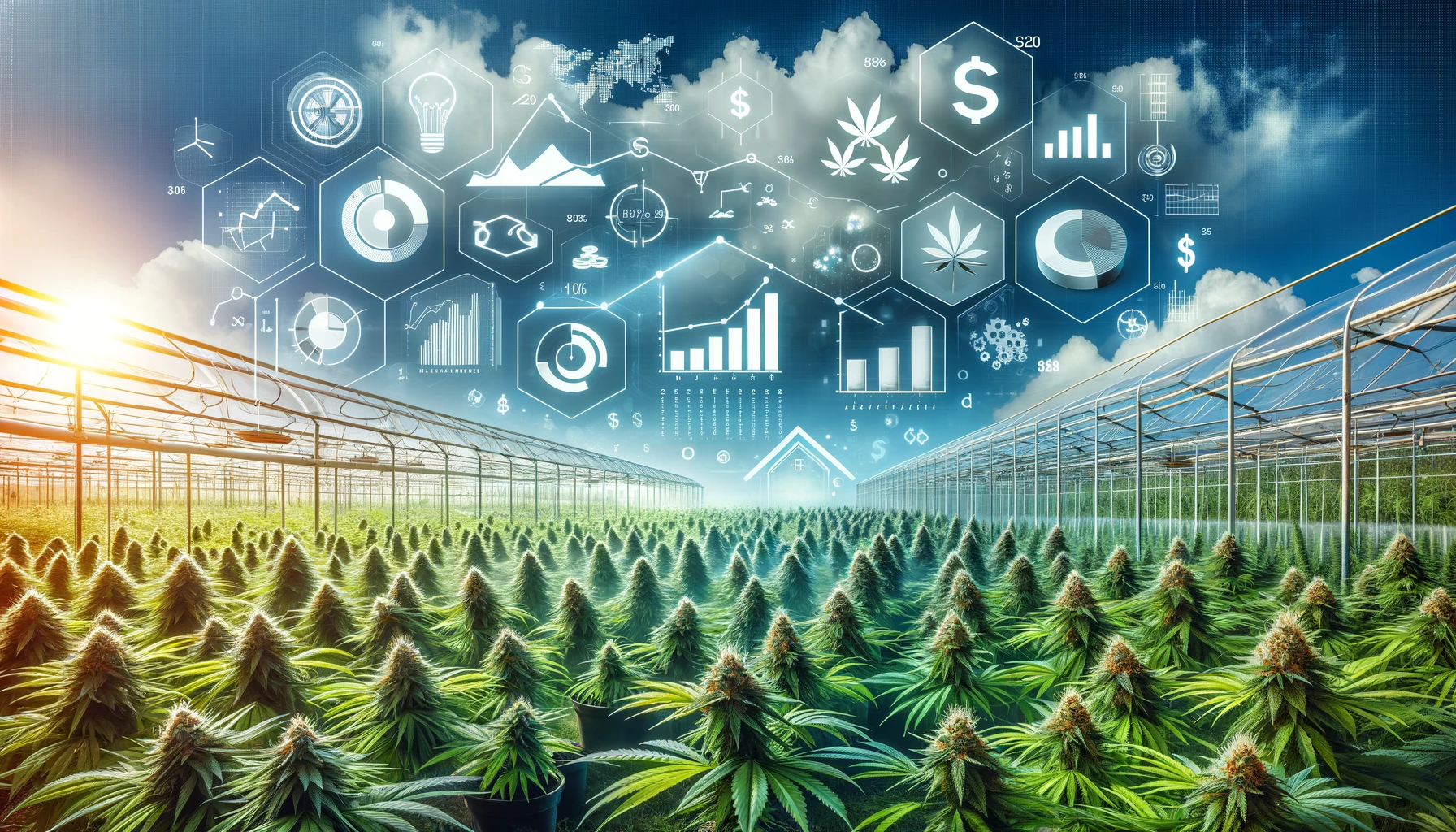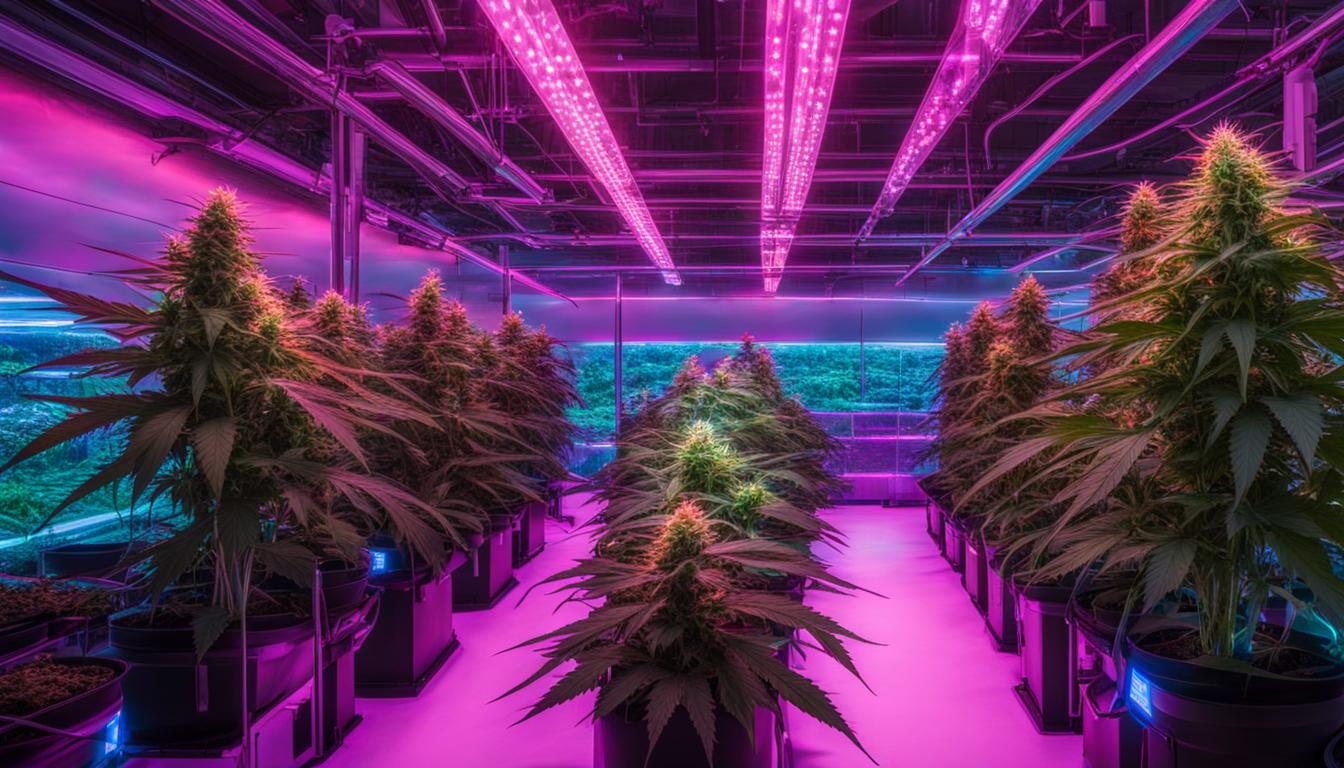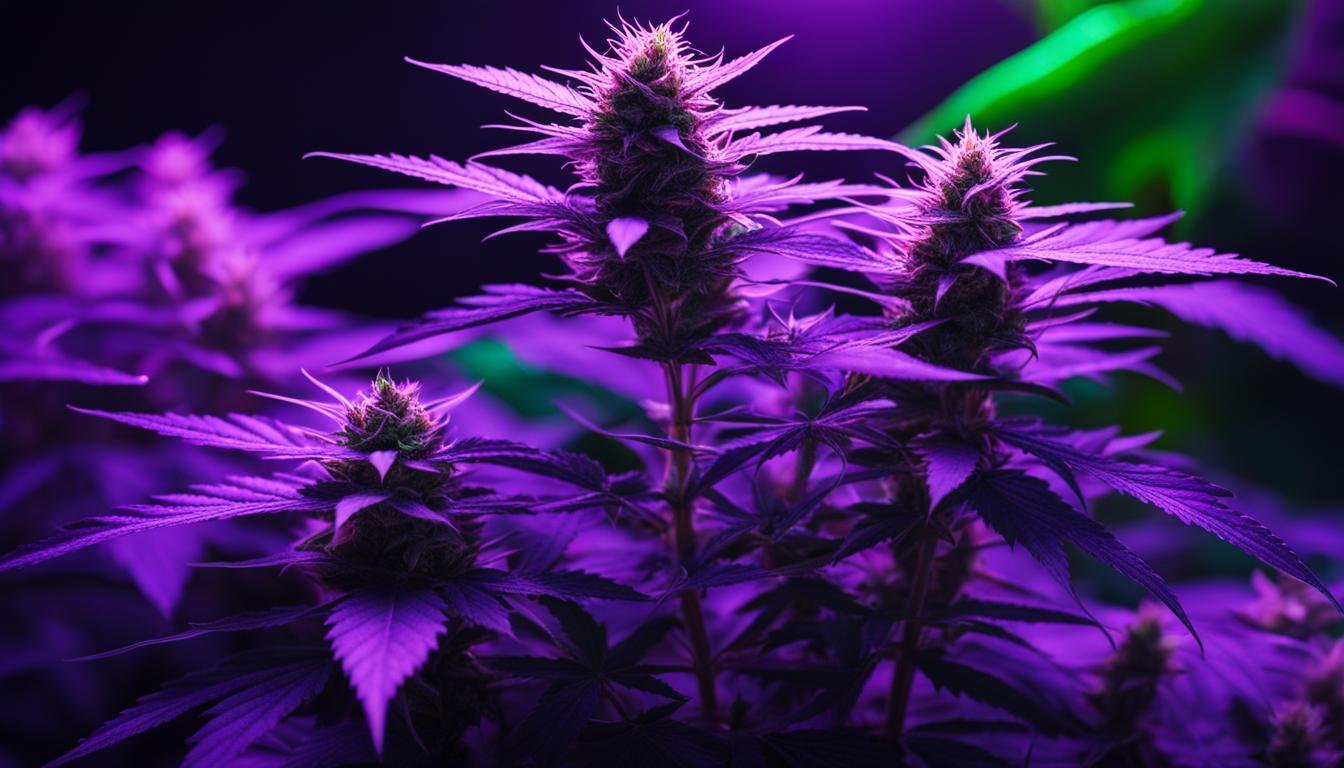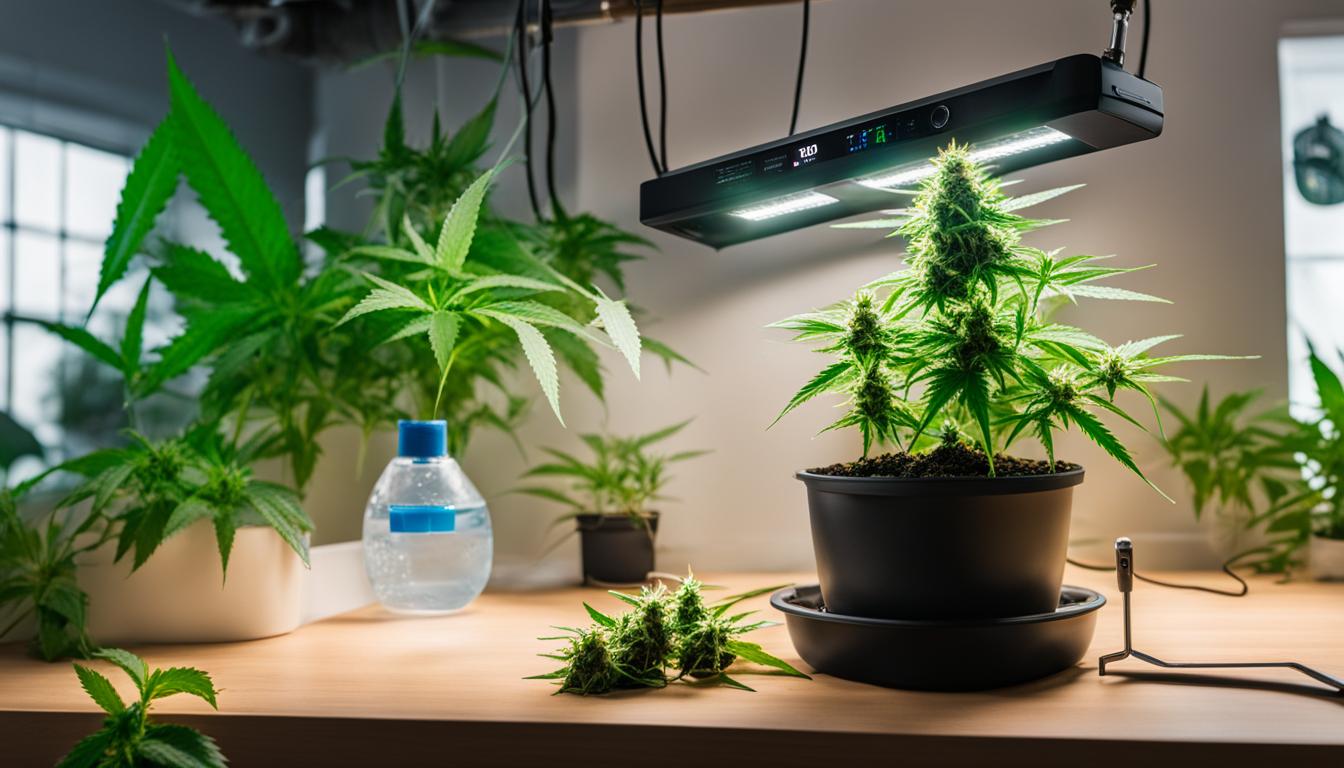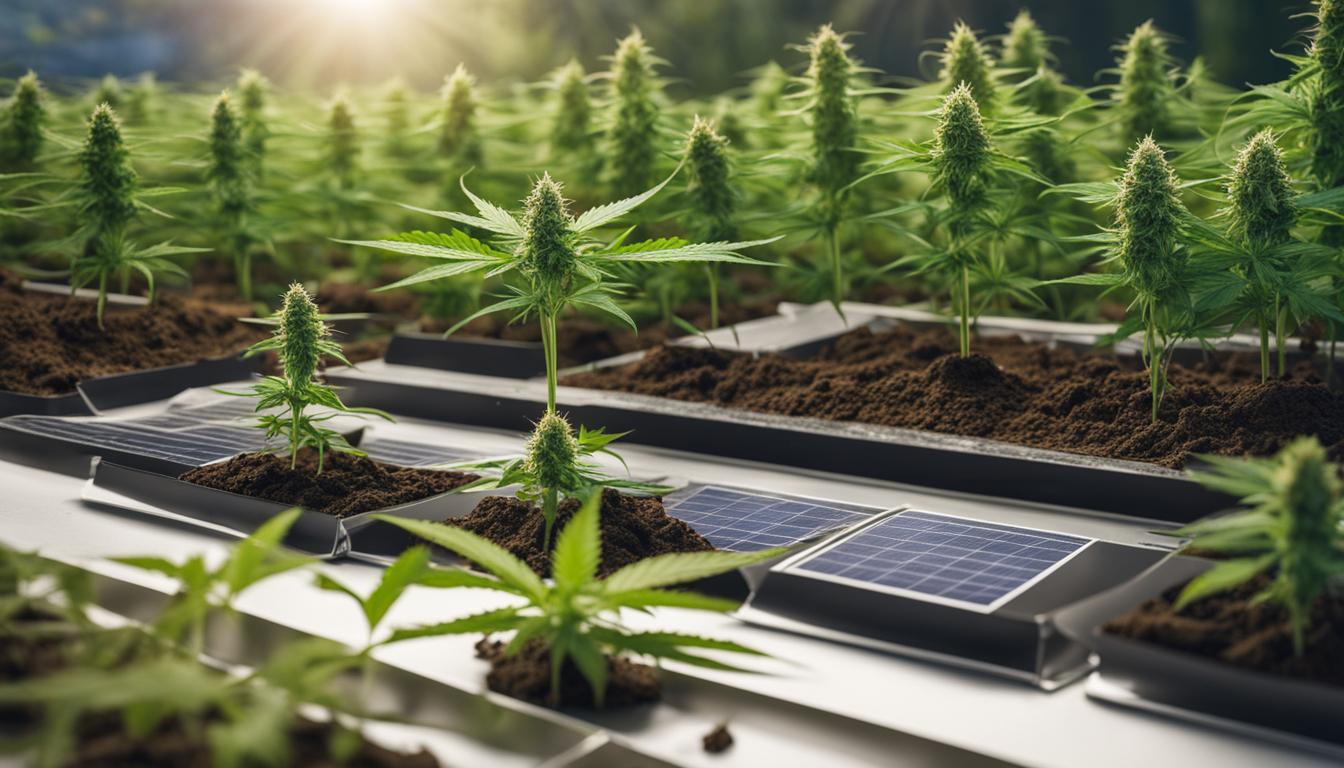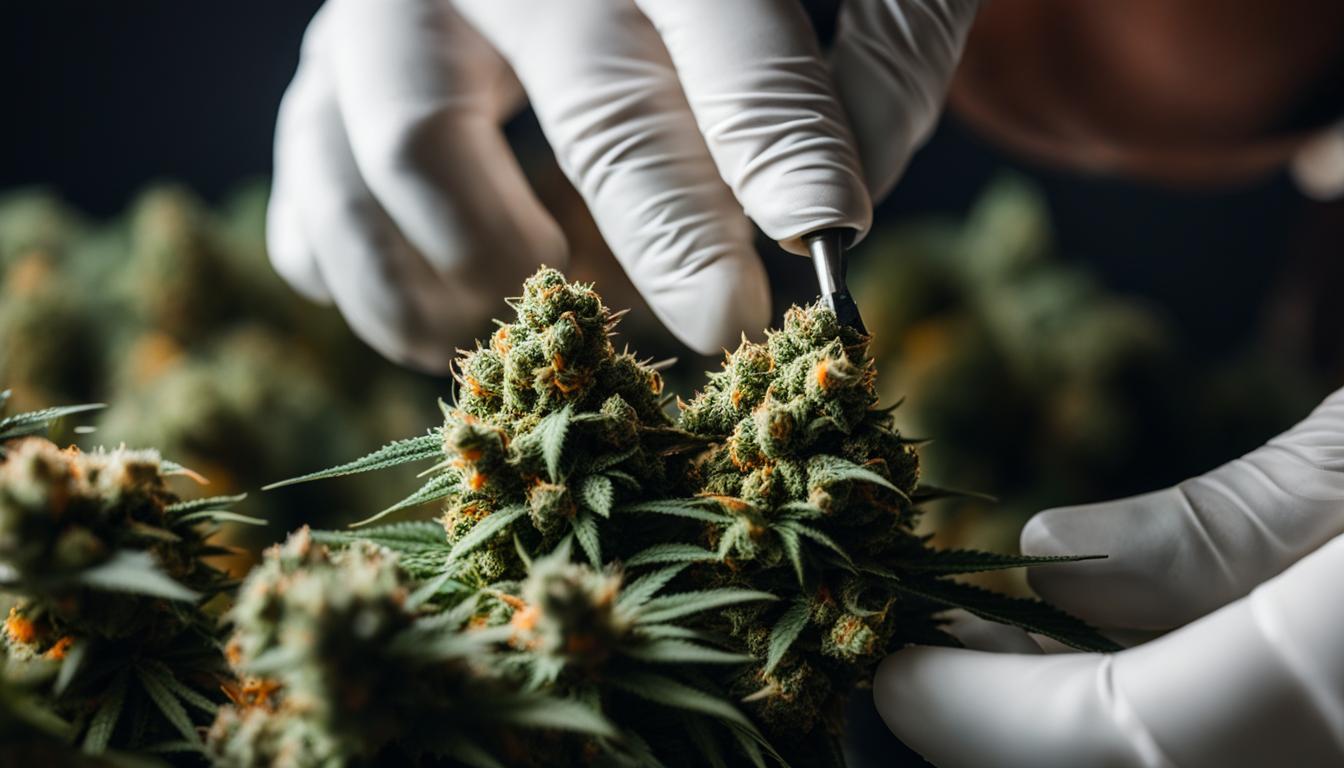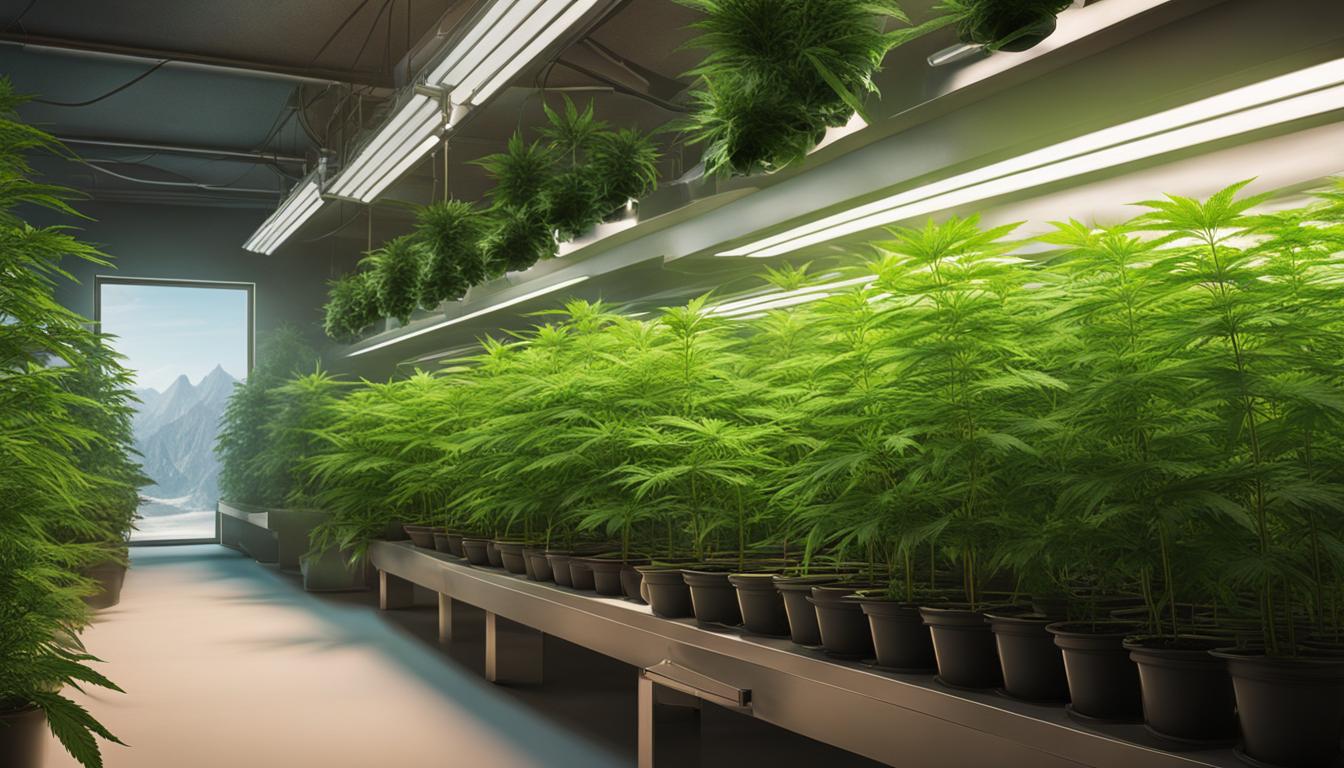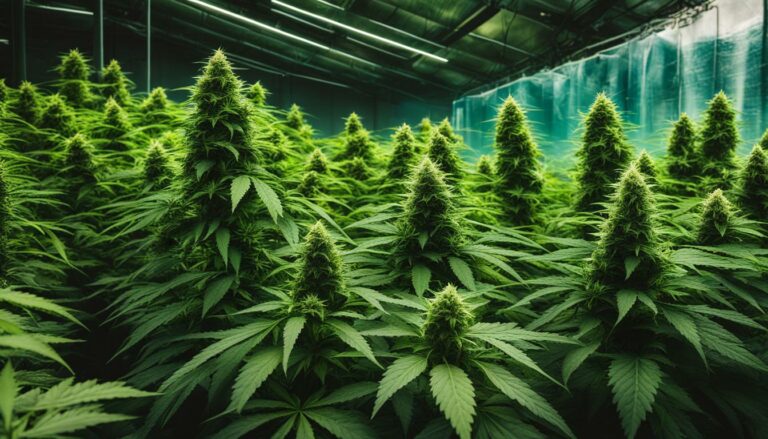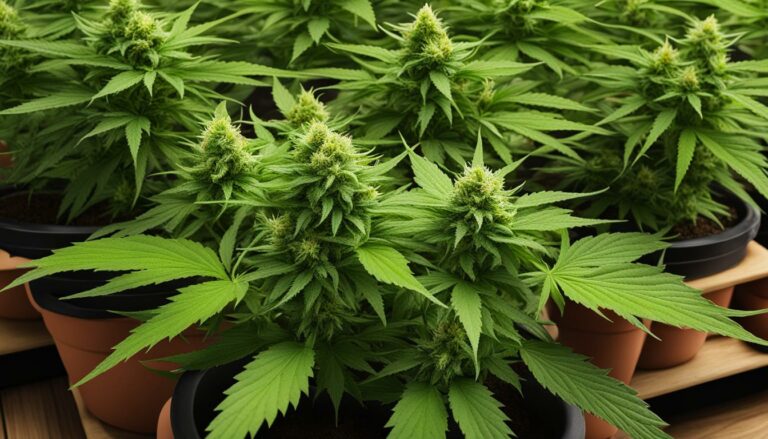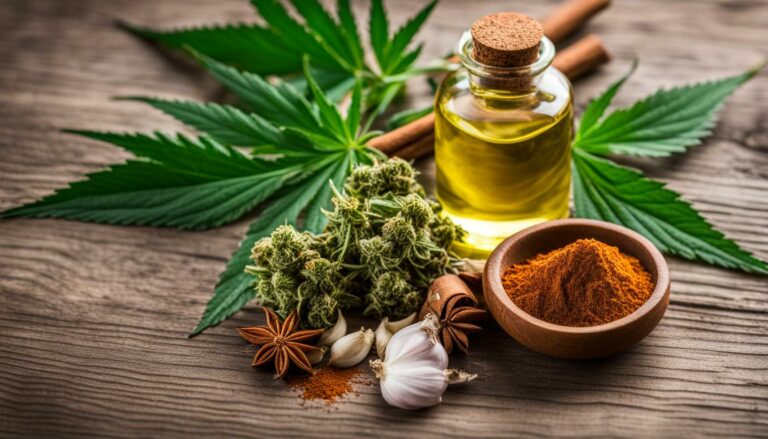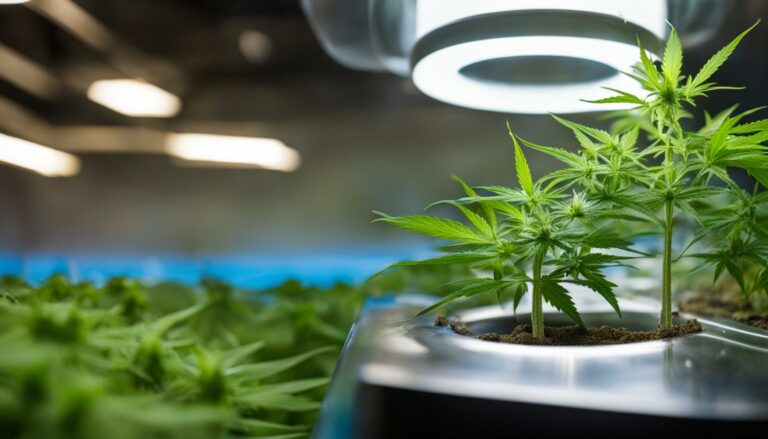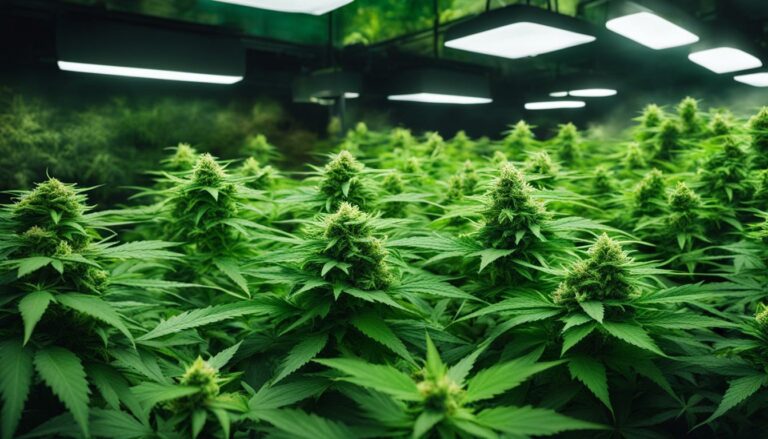The Economics of Growing Cannabis at Home
Welcome to our comprehensive guide on the economics of growing cannabis at home. In this article, we will explore the various aspects of cannabis cultivation economics, including cultivation costs, potential profits, and strategies for optimizing yield. Whether you’re a seasoned grower or a beginner in the industry, understanding the financial dynamics of cannabis cultivation is crucial for success.
Before diving into the nitty-gritty of cannabis cultivation economics, let’s take a moment to appreciate the immense potential for profitability. With the global cannabis market booming, there has never been a better time to explore the economic advantages of home cultivation. From maximizing your cannabis yield to analyzing various business models, we will cover it all in this comprehensive guide.
Our aim is to provide you with valuable insights into the cannabis industry economics and help you make informed decisions about your home grow operation. Whether you’re interested in understanding the cannabis cultivation ROI or exploring different cost optimization strategies, this article will serve as your go-to resource for cannabis market analysis.
So, grab a cup of tea and get ready to delve into the fascinating world of cannabis cultivation economics. By the end of this guide, you’ll have a thorough understanding of the financial implications and be inspired to take control of your own cannabis cultivation journey.
Preparations Between Individual and Commercial Growing
When considering cannabis cultivation, it is essential to understand the financial implications and differences between individual and commercial setups. Both options have their own costs and profits, and choosing the right approach depends on various factors, including your goals and resources.
In individual cannabis cultivation, the focus is on growing plants for personal use or a small-scale operation. This approach offers flexibility and control over the cultivation process. Individual growers have the freedom to experiment with different strains and techniques without the constraints of commercial regulations. However, it’s important to note that individual cultivation comes with its own set of expenses.
On the other hand, commercial cannabis cultivation involves larger-scale operations with the aim of producing cannabis for sale. This requires substantial upfront investments in equipment, licensing, and facility setup. Commercial growers need to comply with regulatory frameworks, such as obtaining the necessary permits and adhering to strict quality control standards. While commercial cultivation has the potential for greater profits, it also entails higher costs and risks.
| Individual | Commercial | |
|---|---|---|
| Setup Costs | Lower initial investment | Higher initial investment for equipment, licensing, and facility setup |
| Profits | Smaller scale, limited profits | Potential for higher profits |
| Regulations | Less regulatory compliance required | Strict regulatory compliance |
| Risk | Lower financial risk | Higher financial risk |
Deciding between individual and commercial cannabis cultivation involves a careful evaluation of your financial capacity, long-term goals, and access to resources. While commercial cultivation offers the potential for larger profits, it also comes with increased expenses and regulatory complexity. Individual cultivation provides more flexibility and control but may not offer the same level of financial returns. By considering these factors, you can make an informed decision that aligns with your goals and resources.
Cost of Every Component
When it comes to setting up a cannabis cultivation operation, there are several components that contribute to the overall cost. From grow lights to permits, each element plays a crucial role in the success and profitability of the venture.
Grow Lights
Grow lights are essential for providing the necessary light spectrum for cannabis plants during their growth stages. Depending on the size of your operation, the cost of grow lights can vary significantly. High-quality LED lights can range from £200 to £1000 per unit, while traditional HPS lights may cost anywhere from £100 to £500 per unit.
Air Circulation
Proper air circulation is crucial for the health of your cannabis plants. This includes fans, ventilation systems, and carbon filters to maintain optimal temperature and humidity levels. The cost of air circulation equipment can range from £100 to £500, depending on the size and complexity of your setup.
Grow Tent
A grow tent provides a controlled environment for your cannabis plants. The cost of a grow tent can vary based on size, quality, and features such as reflective materials and ventilation openings. Smaller tents suitable for personal use may cost around £100, while larger commercial-grade tents can range from £500 to £1000 or more.
Seeds
Choosing the right genetics is essential for a successful cannabis cultivation operation. The cost of cannabis seeds can vary depending on the strain and supplier. On average, you can expect to pay around £10 to £15 per seed for premium genetics.
Purchase or Lease the Property
The cost of acquiring or leasing property for your cannabis cultivation operation can vary greatly depending on location and local regulations. Purchasing property can involve significant upfront costs, including down payments and legal fees. Alternatively, leasing a property may require a security deposit and monthly rent payments. It is essential to consider these expenses when planning your budget.
Design/Construction
Designing and constructing a suitable facility for cannabis cultivation involves various costs, including architectural and engineering fees, construction materials, and labor. The construction cost can range from a few thousand pounds for a small-scale operation to hundreds of thousands for large-scale commercial facilities.
Business License/Individual License
In order to legally operate a cannabis cultivation business, you will need to obtain the necessary licenses and permits. These can include a business license, individual license, and any specific permits related to cannabis cultivation. The cost of licensing and permits can vary depending on your location but can range from a few hundred to several thousand pounds.
Construction Permit
Before starting construction on your cannabis cultivation facility, you will need to obtain a construction permit. The cost of a construction permit can vary depending on the size and complexity of your operation, as well as local regulations. It is important to factor in this cost when planning your budget.
Occupancy Certificate
Once your cannabis cultivation facility is complete, you will need to obtain an occupancy certificate to legally operate. The cost of an occupancy certificate can vary depending on your location and the requirements set by local authorities.
Electricity
Electricity is one of the most significant ongoing costs for a cannabis cultivation operation. The energy requirements for lighting, air circulation, and other equipment can be substantial. It is important to budget for monthly electricity expenses and explore energy-efficient options to reduce costs.
As you can see, there are several components that contribute to the overall cost of setting up a cannabis cultivation operation. From grow lights and air circulation systems to licenses and permits, each element must be considered when planning your budget. By understanding the cost breakdown of each component, you can make informed decisions and optimize your financial investment in cannabis cultivation.
| Component | Average Cost Range (£) |
|---|---|
| Grow Lights | £200 – £1000 per unit |
| Air Circulation | £100 – £500 |
| Grow Tent | £100 – £1000+ |
| Seeds | £10 – £15 per seed |
| Purchase or Lease the Property | Varies based on location |
| Design/Construction | Varies based on scale and complexity |
| Business License/Individual License | £100 – £5000+ |
| Construction Permit | Varies based on location and scale |
| Occupancy Certificate | Varies based on location |
| Electricity | Varies based on energy requirements |
Other Common Questions
When it comes to the economics of cannabis cultivation, there are several common questions that arise. Let’s explore some of these questions and provide insights into labor costs, additional expenses, the ideal number of plants to save money, the cost of growing marijuana indoors, and strategies for reducing cultivation costs.
1. Labor Costs
One of the factors that can significantly impact the economics of cannabis cultivation is labor costs. Depending on the scale of your operation, you may need to hire employees or plan for your own time and effort. It’s important to consider the cost of labor when calculating the overall expenses of your home grow. Additionally, it’s worth exploring different cultivation methods that may require less labor, such as automation or implementing efficient systems.
2. Additional Costs
Besides the initial setup costs, there may be additional expenses that arise throughout the cultivation process. These can include ongoing maintenance, pest control, fertilizers, and utilities. It’s crucial to budget for these additional costs to ensure the financial sustainability of your home grow operation. By planning ahead and considering all possible expenses, you can avoid unexpected financial setbacks.
3. Number of Plants to Save Money
One common question among home growers is how many plants are ideal for saving money. While the answer may vary depending on several factors, such as local regulations and available space, growing a larger number of plants does not always guarantee cost savings. It’s essential to consider the space, lighting, and resources available to you and determine an optimal number of plants that you can effectively manage and maintain. Quality over quantity should be a guiding principle when it comes to maximizing your savings.
4. Cost of Growing Marijuana Indoors
Growing marijuana indoors offers several advantages, such as better control over environmental factors and the ability to cultivate year-round. However, it also comes with additional costs. Indoor cultivation requires investing in equipment such as grow lights, ventilation systems, and air conditioning. These costs should be factored into your overall budget when considering the economics of cannabis cultivation. It’s important to weigh the benefits of indoor growing against the expenses to make an informed decision.
5. Reducing Cultivation Costs
Reducing cultivation costs is a goal for many home growers. There are several strategies you can implement to achieve this, such as selecting cost-effective equipment, optimizing your growing space, using energy-efficient lighting, and exploring organic farming practices. Additionally, staying updated on industry trends and best practices can help you identify innovative methods for reducing costs while maintaining the quality of your cannabis crop.
| Question | Answer |
|---|---|
| Labor Costs | Consider the cost of labor and explore efficient cultivation methods. |
| Additional Costs | Budget for ongoing expenses like maintenance and pest control. |
| Number of Plants to Save Money | Determine an optimal number that balances resources and savings. |
| Cost of Growing Marijuana Indoors | Weigh the benefits against the additional expenses of indoor cultivation. |
| Reducing Cultivation Costs | Implement strategies such as selecting cost-effective equipment and exploring organic farming practices. |
Understanding Dispensary Prices
When it comes to purchasing cannabis from a dispensary, many consumers find themselves faced with high prices. Several factors contribute to the cost of cannabis at dispensaries, including state regulations, taxes, supply and demand dynamics, and the knowledge level among dispensary staff, or budtenders.
State regulations play a significant role in determining cannabis prices. Each state has its own set of laws and regulations governing the cultivation, distribution, and sale of cannabis. These regulations can influence the cost of cannabis products by imposing fees or restrictions on dispensaries, which then get passed on to the consumer.
Taxes also play a crucial role in the pricing of cannabis at dispensaries. Depending on the state, there may be sales taxes, excise taxes, or additional taxes specific to cannabis products. These taxes can significantly increase the final price paid by the consumer.
Supply and demand dynamics
Supply and demand dynamics also impact dispensary prices. If there is a high demand for cannabis products and a limited supply, prices are likely to be higher. Conversely, if there is an oversupply of cannabis, prices may decrease as dispensaries compete for customers.
“The prices of cannabis at dispensaries are influenced by a variety of factors, including state regulations, taxes, supply and demand dynamics, and the knowledge level of dispensary staff.”
Finally, the knowledge level of dispensary staff, known as budtenders, can affect prices. Budtenders are responsible for assisting customers and providing information about different cannabis products. Dispensaries with well-trained and knowledgeable budtenders may charge higher prices to reflect the added value of their expertise.
In summary, cannabis dispensary prices are influenced by state regulations, taxes, supply and demand dynamics, and the level of knowledge among dispensary staff. Understanding these factors can help consumers make informed decisions when purchasing cannabis products from dispensaries.
Cost Comparison: Home Grow vs Dispensary Purchase
When it comes to growing cannabis, many enthusiasts wonder whether it’s more cost-effective to cultivate their own plants at home or continue purchasing from dispensaries. This cost comparison aims to shed light on the financial implications of both options, exploring the potential savings and return on investment.
Home Grow Costs
Setting up a home grow operation incurs various expenses, including equipment, lighting, irrigation systems, genetics, and ongoing maintenance. While the initial investment can be significant, the long-term savings can outweigh the upfront costs.
To give you an idea of the expenses involved, here’s a breakdown of the typical costs:
| Component | Cost |
|---|---|
| Grow Lights | £200 – £1,500 |
| Irrigation System | £100 – £500 |
| Seeds/Clones | £20 – £200 |
| Grow Tent | £100 – £300 |
In addition to these costs, you’ll also need to account for ongoing expenses such as electricity, nutrients, and any necessary pest control measures. These costs can vary depending on the size of your grow operation and your specific requirements.
Dispensary Prices
On the other hand, purchasing cannabis from dispensaries offers convenience and a wide variety of strains, but it generally comes at a higher cost. Dispensary prices can vary depending on factors such as location, strain availability, and quality.
While specific pricing details may differ between dispensaries, a general estimate for the cost of marijuana from a reputable dispensary is around £10 – £15 per gram. If you consume cannabis regularly, these costs can quickly add up over time.
Cost Savings and Return on Investment
When comparing the costs of home cultivation to dispensary purchases, it’s important to consider the potential savings and return on investment. By growing your own cannabis, you can significantly reduce your expenses in the long run.
Based on an average yield per plant and the cost of production, home growers can expect to achieve cost savings of around 50-70% compared to purchasing from dispensaries. Additionally, the return on investment for a home grow can be substantial, particularly when considering the ongoing savings over time.
Ultimately, the decision between a home grow and purchasing from a dispensary depends on various factors, including your budget, time availability, and level of expertise. However, for those willing to invest the time and effort, growing cannabis at home can provide substantial cost savings and a rewarding experience.
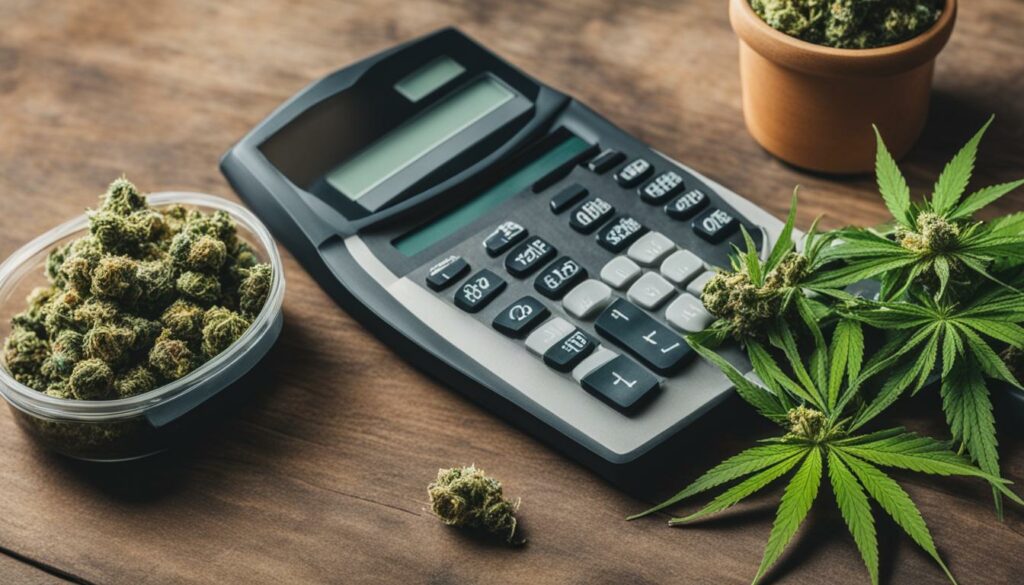
Setting Up Your Home Grow
When it comes to setting up a successful cannabis grow operation at home, there are several key considerations to keep in mind. From equipment and lighting to irrigation systems, genetics, and plant count, each aspect plays a crucial role in determining the success and cost-effectiveness of your home cultivation.
Equipment and Lighting
Investing in the right equipment and lighting is essential for creating an optimal growing environment for your cannabis plants. High-quality grow lights, such as LED or HID lights, provide the necessary spectrum and intensity of light required for healthy plant growth. While the upfront cost of such lighting systems may be higher, they are energy-efficient and have a longer lifespan, resulting in cost savings in the long run.
Irrigation Systems
Proper irrigation is crucial for supplying the right amount of water and nutrients to your cannabis plants. Depending on your setup and preferences, you can choose between various irrigation systems, such as drip systems or hydroponics. Each system has its advantages and cost implications, so it’s important to consider factors like water usage, maintenance requirements, and potential savings in nutrient usage.
Genetics and Plant Count
The genetics of your cannabis plants can significantly impact your yield and overall cost-effectiveness. Choosing high-quality seeds or clones from reputable sources ensures that you start with healthy and resilient plants. Additionally, determining the optimal plant count for your grow space is crucial for maximizing yield. While growing more plants may increase your workload, it can also result in higher returns if managed effectively.
By carefully considering and investing in these key aspects of your home cannabis grow setup, you can create an environment that maximizes yield and minimizes costs. The right equipment, lighting, irrigation systems, genetics, and plant count are the foundations of a successful and cost-effective home cultivation operation.
| Component | Average Cost |
|---|---|
| Grow Lights | $300 – $1,500 |
| Irrigation System | $100 – $500 |
| Genetics (Seeds or Clones) | $50 – $200 |
| Plant Count | Varies based on grow space |
Estimating Yield and Potential Savings
When it comes to growing cannabis at home, one of the key factors to consider is the average yield per plant. This metric can vary depending on various factors such as strain, growing conditions, and cultivation techniques. On average, a well-maintained cannabis plant can yield anywhere from 0.5 to 1.5 ounces of dried flower.
To estimate the potential annual yield for a home grow, you’ll need to determine the number of plants you plan to cultivate. Let’s say you decide to grow four plants, and each plant yields an average of 1 ounce. That would give you a total yield of 4 ounces per harvest. Assuming you have three harvests per year, you could potentially achieve an annual yield of 12 ounces.
Now, let’s talk about cost per ounce. The cost of growing cannabis at home can vary depending on your setup, but it’s generally more cost-effective compared to purchasing from a dispensary. While the initial setup costs may be higher, the ongoing expenses such as electricity and nutrients are usually lower. This can result in significant savings in the long run.
| Component | Cost |
|---|---|
| Grow Lights | £200 |
| Nutrients | £50 |
| Electricity | £30 per month |
| Seeds | £40 |
| Other Supplies | £100 |
| Total | £420 |
Based on these estimates, the cost per ounce of homegrown cannabis would be approximately £35 (£420 / 12 ounces). This is significantly lower than the average cost per ounce at dispensaries, which can range from £100 to £200. By growing your own cannabis, you could potentially save hundreds or even thousands of pounds per year.
Long-Term Cost Analysis
In this section, we will conduct a comprehensive cost analysis to compare the expenses of a home cannabis grow over five years with the cost of consistently buying from dispensaries. By understanding the long-term financial implications, you can make an informed decision about whether home cultivation is the right choice for you.
It’s important to consider the initial setup costs mentioned in Section 7, such as equipment, lighting, irrigation systems, and genetics. However, these costs are one-time investments that can be spread over the course of several years, making them more manageable.
On the other hand, when buying from dispensaries, the costs accumulate with each purchase. Dispensary prices can be significantly higher due to various factors mentioned in Section 5, including state regulations, taxes, supply and demand dynamics, and the knowledge level of dispensary staff. Over time, these costs can add up substantially, impacting your overall expenditure.
Five-Year Cost Comparison
Let’s break down the cost comparison between home cultivation and dispensary purchases over a five-year period. For simplicity, we’ll assume that the initial setup costs for a home grow amount to £500. This includes all the necessary equipment, lighting, irrigation systems, and genetics.
| Year | Home Cultivation Expenses | Dispensary Purchases |
|---|---|---|
| 1 | £500 | £2,000 |
| 2 | £0 | £2,000 |
| 3 | £0 | £2,000 |
| 4 | £0 | £2,000 |
| 5 | £0 | £2,000 |
As you can see from the table above, the initial investment for home cultivation is £500, while the total cost of dispensary purchases over five years amounts to £10,000. This analysis clearly demonstrates the significant cost savings that can be achieved through home cultivation. By growing your own cannabis, you can save thousands of pounds over time while enjoying a consistent supply of high-quality, homegrown product.
Keep in mind that these calculations are based on general estimates and may vary depending on your specific circumstances. However, they offer a helpful perspective on the long-term financial benefits of home cultivation. Don’t miss out on the potential savings and the rewarding experience of nurturing your own cannabis crop!
Related Articles
- What Are the Costs Associated with Growing Cannabis at Home?
- How to Budget for a Home Cannabis Grow Operation?
- Can Growing Cannabis at Home Be Profitable?
- What Are the Financial Considerations for Small Scale Cannabis Growers?
- How to Reduce Costs in Home Cannabis Cultivation?
Conclusion
After exploring the economics of growing cannabis at home, it’s clear that there are numerous benefits and economic advantages to be gained. Home cultivation allows individuals to take control of their cannabis supply, reducing their reliance on dispensaries and potentially saving a significant amount of money in the long run.
By setting up a home grow, you can not only customize your cultivation environment to optimize yield and quality but also eliminate the markups associated with dispensary prices. With careful planning and investment in the right equipment, you can achieve a cost-effective cannabis cultivation setup that suits your needs and preferences.
Furthermore, growing cannabis at home offers the added advantage of self-sufficiency. You can cultivate your favorite strains, experiment with new genetics, and enjoy the satisfaction of harvesting your own high-quality cannabis. Not only does this contribute to a more sustainable lifestyle, but it also provides a sense of accomplishment and connection to the plant.
In conclusion, embracing home cultivation provides not only financial benefits but also an opportunity for personal growth and self-sustainability. By understanding the economics of growing cannabis at home, you can unlock the ability to produce your own cannabis, enjoy cost savings, and have a rewarding and empowering experience as a cannabis cultivator.

FAQ
What are the costs involved in growing cannabis at home?
The costs associated with growing cannabis at home include the purchase of equipment such as grow lights, air circulation systems, and grow tents, as well as expenses for seeds, property acquisition or lease, design and construction, licenses and permits, and electricity.
How do the financial considerations differ between individual and commercial cannabis cultivation?
Individual cannabis cultivation typically has lower upfront costs and potential profits compared to commercial cultivation. Commercial setups require larger investments in property, infrastructure, and licensing, but also have the potential for higher profits.
What components contribute to the costs of cannabis cultivation?
The components that contribute to the costs of cannabis cultivation include grow lights, air circulation systems, grow tents, seeds, property acquisition or lease, design and construction, licenses and permits, and electricity.
What are some common questions related to the economics of cannabis cultivation?
Common questions related to cannabis cultivation economics include labor costs, additional expenses, the ideal number of plants to save money, the cost of indoor cultivation, and strategies for reducing cultivation costs.
Why are cannabis prices high at dispensaries?
The high prices of cannabis at dispensaries are influenced by factors such as state regulations, taxes, supply and demand dynamics, and the level of knowledge among dispensary staff.
Is it more cost-effective to grow cannabis at home or purchase from a dispensary?
Growing cannabis at home can be more cost-effective than purchasing from a dispensary, as it allows for potential cost savings and a return on investment over time.
What are the initial setup costs for a home cannabis grow?
The initial setup costs for a home cannabis grow include expenses for equipment, lighting options, irrigation systems, plant genetics, and the number of plants to grow.
What is the average yield per cannabis plant and the potential annual yield for a home grow?
The average yield per cannabis plant can vary, but a home grow has the potential for significant annual yield. The cost per ounce can be estimated based on these yields, highlighting the potential savings of home cultivation.
How do the long-term costs of a home grow compare to consistently purchasing from dispensaries?
A long-term cost analysis shows that a home grow over five years can result in significant cost savings compared to consistently purchasing cannabis from dispensaries.

